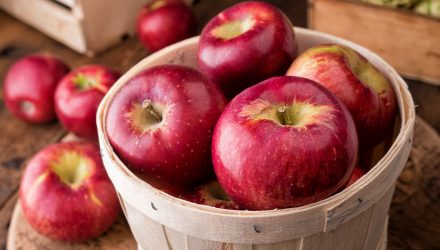Apple prices in China are up almost 30%, detracting from its consumption for the commodity, according to the latest data from grocery delivery platform Dada-JD Daojia. This latest development could put consumer sentiment and spending on watch in China as the trade impasse with the United States gets longer in the tooth.
According to the latest government figures, China’s consumer price index rose in May to 2.7 percent, which represents its highest in over a year. Contributing to this figure was an 18.2 percent climb in pork prices and a 26.7% increase in fruit prices.
Earlier this month, the Ministry of Commerce published a statement to assure the public that the increase in fruit prices like apples was temporary.
“Although inflation data continues to rise, future increases are limited, and the overall pressure is controllable,” said Jianguang Shen, chief economist at JD Digits, which was spun off from Chinese e-commerce company JD.com.
This could put China commodities in play, but an easier way for investors to participate in commodities is through a commodity exchange-traded fund (ETF). Investing through an ETF will allow investors to reap benefits, such as tax efficiency.
But exactly how do commodity ETFs work?
How Do Commodity ETFs Work?
Commodities come in a variety of options. Each commodity has its own nuances with respect to how their markets react to certain conditions affecting their respective industry.
Examples of Commodities
- Precious Metals: gold, silver, platinum, palladium, and copper
- Livestock: pork bellies and cattle
- Agricultural: corn, soybeans, wheat, rice, cocoa, coffee, cotton, and sugar
- Energy: oil, natural gas and gasoline
As mentioned, commodity ETFs can hold the actual assets and place them in a physical storage area. Other ETFs prefer to trade the contracts tied to the commodities, track a commodity index or a combination thereof.
An investor in a commodity ETF does not typically own the actual commodity itself. Instead, an investor can own the contracts backed by the commodity.
The performance of the commodity will determine the value of the contract at the time it is bought and sold. ETFs investing in commodities typically use leverage, which is borrowed capital.
By using leverage, the commodity ETF has excess cash to invest in risk-free assets like Treasury bills as a hedge against the contracts. This protects the fund and its investors in the event of a downturn in that respective commodity market.
The commodity ETF will typically create its own benchmark index to track the performance of the fund. Depending on the ETF, these commodities can track precious metals, energy or whatever commodity comprises the fund focus.
The performance of that proprietary index created by the fund will determine its performance. Since the performance is tied to an index, one thing to take note of is that tracking error could result in a commodity ETF–the price difference between an investment and that of the index.
Examples of Commodity ETFs:
- SPDR Gold Shares (NYSEArca: GLD)
- iShares Silver Trust (NYSEArca: SLV)
- Energy Select Sector SPDR (NYSEArca: XLE)
- VanEck Vectors Agribusiness ETF (NYSEArca: MOO)
- United States Natural Gas Fund (NYSEArca: UNG)
- United States Oil (NYSEArca: USO)
- Teucrium Soybean Fund (NYSEArca: SOYB)
- Teucrium Wheat Fund (NYSEArca: WEAT)
- Aberdeen Standard Bloomberg All Commodity Strategy K-1 Free ETF (NYSEArca: BCI)
- Invesco DB Commodity Index Tracking Fund (NYSEArca: DBC)
- iShares S&P GSCI Commodity-Indexed Trust (NYSEARCA: GSG)
- United States Commodity Index Fund (NYSEArca: USCI)
For more educational information on ETFs, click here for Education Central.


